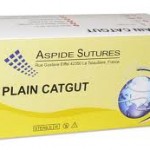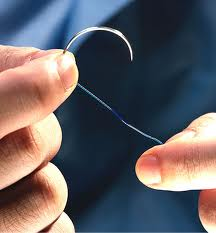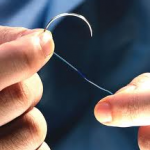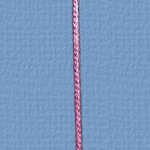For centuries, dentists and oral surgeons, plastic surgeons, obstetricians, urologists and even veterinarians have used stitches to close up gashes, cuts and surgical incisions. Now, many physicians are using some form of dissolvable stitches (also called absorbable sutures). The great thing about dissolvable stitches is that they can be used on internal or external wounds.
Stitches, dissolvable or non-dissolvable, have three features:
- Thickness – Some stitches must be thin (perhaps for a simple cut or plastic surgery, or a wound that needs to heal with less scarring), and others thicker (perhaps for internal wounds where scarring isn’t as worrisome, or so the stitch will last longer). To make a thicker stitch, more of the material is woven together. For a thinner stitch, less material is woven together.
- Elasticity - Stitches on your knee need to be more elastic than those on your forearm, because your knee must be able to bend. Without proper elasticity, the stitches can snap and come out, or even tear the wound and delay healing.
- Decomposition rate – A deep, wide wound will need longer to heal, so the stitches will have to last longer. Stitches can be formulated and strengthened to dissolve slowly or rapidly over the desired treatment period.
Dissolvable stitches differ from non-absorbable stitches because they are:
- naturally decomposed by the body
- temporary, and don’t usually require a follow-up doctor’s visit to remove the stitches or check on the wound
ÂTo your body, stitches are a foreign substance, and the body is programmed to destroy foreign substances. Dissolvable stitches are made from natural materials, such as processed collagen (animal intestines), silk and hair, as well as some synthetic materials that the body can break down. This allows the body to dissolve the stitches over time. Usually, by the time the stitches are dissolved, the wound is completely healed.
 Absorbable sutures were originally made of the intestines of sheep, the so called catgut. The manufacturing process was similar to that of natural musical strings for violins and guitar, and also of natural strings for tennis racquets. Today, gut sutures are made of specially prepared beef and sheep intestine, and may be untreated (plain gut), tanned with chromium salts to increase their persistence in the body (chromic gut), or heat-treated to give more rapid absorption (fast gut). However, the majority of absorbable sutures are now made of synthetic polymer fibres, which may be braided or monofilament; these offer numerous advantages over gut sutures, notably ease of handling, low cost, low tissue reaction, consistent performance and guaranteed non-toxicity. In Europe and Japan, gut sutures have been banned due to concerns over bovine spongiform encephalopathy (mad-cow disease), although the herds from which gut is harvested are certified BSE-free. Each major suture manufacturer has its own proprietary formulations for its brands of synthetic absorbable sutures; various blends of polyglycolic acid, polylactic acid or caprolactone are common.
Absorbable sutures were originally made of the intestines of sheep, the so called catgut. The manufacturing process was similar to that of natural musical strings for violins and guitar, and also of natural strings for tennis racquets. Today, gut sutures are made of specially prepared beef and sheep intestine, and may be untreated (plain gut), tanned with chromium salts to increase their persistence in the body (chromic gut), or heat-treated to give more rapid absorption (fast gut). However, the majority of absorbable sutures are now made of synthetic polymer fibres, which may be braided or monofilament; these offer numerous advantages over gut sutures, notably ease of handling, low cost, low tissue reaction, consistent performance and guaranteed non-toxicity. In Europe and Japan, gut sutures have been banned due to concerns over bovine spongiform encephalopathy (mad-cow disease), although the herds from which gut is harvested are certified BSE-free. Each major suture manufacturer has its own proprietary formulations for its brands of synthetic absorbable sutures; various blends of polyglycolic acid, polylactic acid or caprolactone are common.
Following are the list of Absorbable Sutures:
Natural Absorbable Sutures
- Catgut Sutures- Plain catgut and Chromic catgut sutures
Synthetic Absorbable Sutures
- Polyglycolic Acid Sutures (PGA sutures)- coated and braided suture
- Polyglactin 910 Sutures (PGLA sutures)- coated and braided suture
- Poliglecaprone Sutures (PGCL sutures)- monofilament suture
- Polydioxanone Sutures (PDS Sutures)- monofilament suture
Sutures also come either as monofilament or braided:
* Monofilament sutures cause less reaction than do braided sutures but require more ties to assure an adequate maintenance of the knot compared to braided suture. Monofilament sutures are usually non- absorbable.
* Braided suture usually incites a greater inflammatory response but requires fewer ties to maintain the knot integrity. These include silk, cotton and Mersilene.
The strength of the sutures varies according to their size, which can be determined by a uniformly applied number. For example, a 6-0 suture is more delicate and has less strength than a 4-0 suture.
Occasionally, a stitch won’t dissolve completely. This usually occurs when part of the stitch is left on the outside of the body. There, the body’s fluids cannot dissolve and decompose the stitch, so it remains intact. A doctor can easily remove the remaining piece of stitch once the wound is closed.
In circumcisions, the problem with self-dissolving stitches is skin tunnels, which are like piercings, that never go away. When used for a circumcision, the stitch passes through the dry outer layer of skin where the blood-stream cannot reach the stitch, so a hole remains. If the dissolving process is relatively slow, the natural healing process forms a tunnel around the stitch. A stitch scar (or tunnel) internally is no problem, but at the site of a circumcision it is unsightly. The probability of scarring or tunnels if the stitches are left in longer than needed leads to the advice to remove them at about 7 days after circumcision, by which time the two cut surfaces of skin will have joined together sufficiently. It is quite possible to manage without any stitches for a circumcision, so there is plenty of safety margin in the 7-day recommendation.


